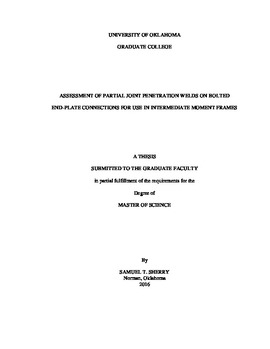| dc.contributor.advisor | Ramseyer, Chris | |
| dc.contributor.author | Sherry, Samuel | |
| dc.date.accessioned | 2016-05-12T21:40:48Z | |
| dc.date.available | 2016-05-12T21:40:48Z | |
| dc.date.issued | 2016-05-13 | |
| dc.identifier.uri | https://hdl.handle.net/11244/34659 | |
| dc.description.abstract | End-plate moment connections are a very common connection type used in the metal building industry today. Bolted end-plate connections are found where a rafter is joined to a column and consist of a steel plate welded to the end of a rafter. The steel plate contains pre-drilled holes which allow the rafter to be easily bolted to a column in the field. Improved weld quality resulting from a controlled manufacturing environment and the cost effectiveness of these connections has made bolted end-plates very popular. Bolted end-plate connections can be engineered to meet design requirements for moment resisting connections used in seismically active areas and in structures that require a higher level of dependability. The current industry standard is to use complete joint penetration (CJP) welds when making the end-plate to flange welds. CJP welds connect the entire thickness of the joining metals. An alternative to CJP is partial joint penetration (PJP), which leaves some portion of the base metals’ thickness unfused. PJP welds save time and money in the fabrication of end-plate connections, but the use of PJP in this application is currently not accepted by the code. The objective of this research is to evaluate the effectiveness of properly detailed built-up PJP flange welds on end-plate connections when subjected to seismic loading. The results of testing the built-up PJP welds on the six-bolt multiple row extended end-plate connections should provide the basis for prequalification of this connection by the American Institute of Steel Construction (AISC).
Two multiple row extended end-plate moment connection tests were conducted at the University of Oklahoma’s Donald G. Fears Structural Engineering Laboratory. The test specimens were 44 inch deep, cantilevered beams connected to a column via a bolted end-plates. A load was applied at the beam’s tip creating a moment at the beam to column connection and created a force acting on the flange welds. The test specimens were tested in accordance with the 2010 AISC Seismic Provision’s criteria on cyclic loading sequences for beam to column moment connections.
The six-bolt multiple row extended end-plate connection with built-up PJP welds passed all the prequalification criteria for use on demand critical welds on intermediate moment frames. No weld failures were observed during testing. Built-up PJP welds used on bolted end-plate connections built according to specific design requirements identified by this testing, should be acceptable as pre-qualified connections according the 2010 AISC Seismic Provision when used for demand critical welds in intermediate moment frames and less stringent connections. The 44 inch deep test sections are to our knowledge the deepest PJP weld tests performed to date. | en_US |
| dc.language | en_US | en_US |
| dc.subject | Partial Joint Penetration Welds | en_US |
| dc.subject | Bolted End-plate | en_US |
| dc.subject | Intermediate Moment Frames | en_US |
| dc.subject | Engineering, Civil | en_US |
| dc.title | Assessment of Partial Joint Penetration Welds on Bolted End-plate Connections for use in Intermediate Moment Frames | en_US |
| dc.contributor.committeeMember | Harvey, Philip Jr. | |
| dc.contributor.committeeMember | Volz, Jeffery | |
| dc.date.manuscript | 2016-05-12 | |
| dc.thesis.degree | Master of Science | en_US |
| ou.group | College of Engineering::School of Civil Engineering and Environmental Science | en_US |
| shareok.nativefileaccess | restricted | en_US |
